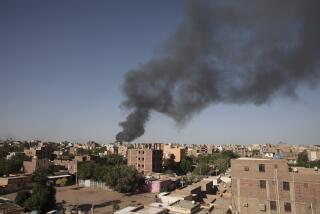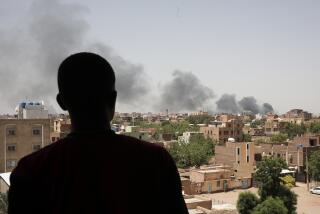Delegates Assess Zaire Refugee Situation
- Share via
STUTTGART, Germany — Countries considering how--and whether--to help the refugees of Central Africa gathered here Friday in an atmosphere of continuing confusion over how many Rwandans remain in eastern Zaire and how dire their plight is.
Delegates from 28 countries and various humanitarian groups offered differing assessments of the scope of the refugee problem and agreed to continue meeting through the weekend to pool information and seek a common understanding.
“We do not have a good handle on what the problem is, and you cannot have a good solution if you don’t have a good handle on the problem,” said Brig. Gen. John T. D. Casey, the chief American staff officer on the planning task force.
The agenda for Friday’s talks included three general options for military assistance for the region.
The U.N. Security Council voted a week ago to send up to 12,000 troops to Central Africa to help get food to hard-pressed Rwandan refugees in eastern Zaire. But in the last week, an estimated 500,000 refugees have returned to their home country, raising questions about what kind of assistance is now appropriate--and doubts about whether a military mission is still needed.
Lt. Gen. Maurice Baril of Canada, which has offered to lead the multinational force, said he hopes a concrete set of proposals will be finished in the next two or three days. Those proposals are then to be taken back to the countries offering assistance for final approval.
According to sources close to the talks, the options being discussed range from keeping military assistance at its present, minimal level to moving international troops into Zaire and “using heavy forces” to establish supply corridors for humanitarian relief deliveries.
A third, middle option consists of providing military support from positions in Rwanda, using only “light force” as needed, to safeguard humanitarian workers.
That proposal would put the multinational troops at less risk, but it would require Rwandan consent. Rwanda has argued that the estimates of needy refugees tend to be far too high, and it has resisted proposals to deploy foreign troops within its borders.
Although it was not immediately clear which option the United States is favoring, Casey appeared eager to dispel any notion that America is about to help a group of armed forces punch its way through Zairian territory racked by rebel fighting.
“ ‘Opening corridors’ has the connotation of going in and fighting your way through a bunch of folks,” he said. “I think that’s perhaps a connotation you would not want to apply to this set of circumstances. We haven’t developed the options in detail yet, but [the plan] certainly doesn’t involve, at this point, going in and fighting anybody for anything.”
Estimates of the number of refugees still remaining in eastern Zaire run as low as 100,000 and as high as 750,000. Canada’s Baril said he had observed about 150,000 people massing in a 35-mile-long corridor in eastern Zaire during a low-altitude flight over the area.
The higher estimate of the refugee population was provided by the U.N. High Commissioner on Refugees, which said it made its count on the basis of satellite photographs and flights over the area.
More to Read
Sign up for Essential California
The most important California stories and recommendations in your inbox every morning.
You may occasionally receive promotional content from the Los Angeles Times.













